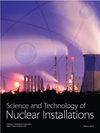A New Experimental Method for the Nonlinear Modal Parameter Identification of a Pressurized Water Reactor Fuel Assembly
IF 0.9
4区 工程技术
Q3 NUCLEAR SCIENCE & TECHNOLOGY
引用次数: 1
Abstract
Establishing a dynamic model that accurately describes a realistic pressurized water reactor (PWR) fuel assembly is crucial to precisely evaluate the mechanical properties of the fuel assembly in seismic or loss of coolant accidents (LOCAs). The pluck test combined with the logarithmic decrement method has been widely applied in previous studies to extract fundamental modal parameters to calibrate dynamic models. However, most previous investigations focused on the first cycle of free vibration, which is strongly affected by stiction, baseline shift, drop conditions, and high-order mode interference, leading to inaccurate results. Moreover, these traditional methods cannot be used to extract high-order modal parameters. In this work, a novel experimental method for identifying the nonlinear modal parameters of a PWR fuel assembly is proposed. First, two algorithms are adopted to decompose the free vibration. Second, the local linearized modal parameters are extracted by a single-degree-of-freedom fitting method with a sliding window. Finally, these local linearized modal parameters are summed to obtain the nonlinear relationships between the modal parameters and amplitude. The new method makes more effective use of experimental data, obtains more accurate modal parameters than the logarithmic decrement method, and is capable of extracting high-order modal parameters. In the end, the test results are fitted by a fractional polynomial, which is of great value for numerical simulations.压水堆燃料组件非线性模态参数识别的一种新实验方法
建立一个准确描述真实压水反应堆(PWR)燃料组件的动力学模型,对于准确评估地震或冷却剂损失事故(LOCA)中燃料组件的机械性能至关重要。在以往的研究中,拔出试验与对数递减法相结合已被广泛应用于提取基本模态参数以校准动态模型。然而,以前的大多数研究都集中在自由振动的第一个周期,它受到静摩擦、基线偏移、跌落条件和高阶模态干扰的强烈影响,导致结果不准确。此外,这些传统方法不能用于提取高阶模态参数。在这项工作中,提出了一种识别压水堆燃料组件非线性模态参数的新实验方法。首先,采用两种算法对自由振动进行分解。其次,采用滑动窗单自由度拟合方法提取局部线性化模态参数。最后,将这些局部线性化的模态参数相加,得到模态参数与振幅之间的非线性关系。新方法比对数递减法更有效地利用了实验数据,获得了更准确的模态参数,并且能够提取高阶模态参数。最后,用分数多项式对试验结果进行了拟合,这对数值模拟具有重要价值。
本文章由计算机程序翻译,如有差异,请以英文原文为准。
求助全文
约1分钟内获得全文
求助全文
来源期刊

Science and Technology of Nuclear Installations
NUCLEAR SCIENCE & TECHNOLOGY-
CiteScore
2.30
自引率
9.10%
发文量
51
审稿时长
4-8 weeks
期刊介绍:
Science and Technology of Nuclear Installations is an international scientific journal that aims to make available knowledge on issues related to the nuclear industry and to promote development in the area of nuclear sciences and technologies. The endeavor associated with the establishment and the growth of the journal is expected to lend support to the renaissance of nuclear technology in the world and especially in those countries where nuclear programs have not yet been developed.
 求助内容:
求助内容: 应助结果提醒方式:
应助结果提醒方式:


